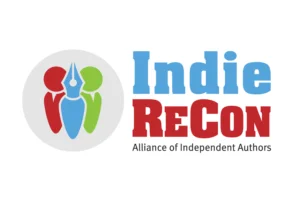Seek out the designer whose work appeals to you personally.
At the bookstore
 Researching in a bookstore is my favorite way to learn about other designers.
Researching in a bookstore is my favorite way to learn about other designers.
- Make a trip to the local book store. Review recently published books. Look at different kinds of titles in different sections. Which covers are most striking to you? The cover should sing and connect with you immediately.
- Jot down the book title and look up the designer's name in the credits section.
- As you look around, assemble a wide and diverse list of candidates.
- Google them. You'll find out that many designers and art directors have portfolio websites.
- Reach out to them. Many of them probably work for their publisher, but they might be available for freelance work.
Online
There are many online freelance design services. These sites showcase designers work and links to portfolio sites. Don't just consider people in your region, branch out. In today's interconnected world you can work with designers in another state or even a foreign country. The New York Times has recently been using illustrators who live and work abroad.
Recommendations
Referrals from friends and colleagues can work, but first and foremost the designer's portfolio must speak to you personally. You must love his work.
Price
 This might be the difficult part. Don't be surprised if your favorite designers ask for higher fees than you might have in your budget.
This might be the difficult part. Don't be surprised if your favorite designers ask for higher fees than you might have in your budget.
Having a wider pool of choice candidates will enable you to shop around and negotiate.
Hiring the Designer
You've found your designer. Set up an initial meeting to explain your project and agree on a work schedule. By this time fees should have already been negotiated, but confirm specifics regarding number of revisions included in the design fee.
You might choose to meet in person, talk by phone, video chat or email. As this is your first work meeting to establish a working relationship, I recommend meeting face to face. If not possible, phone or Skype is my next preferred option.
Communication
Providing information about your book. There's a good chance that the designer you hire might not have the time to read your entire book. Don't take it personally, the important thing is that he or she acquires sufficient knowledge about the book's content to embark on the project.
Provide the designer with a detailed synopsis of your work and a sample chapter. The designer should ask plenty of questions and you should be ready to answer the following:
- Who's your target audience?
- Who do you expect will read your book?
- Does your book have a competition? Which other similar titles should the designer check out?
- Is it going straight to e-book or will there also be a print edition?
Specifications for print and e-book. The designer will also require specs such as a trim size for print edition and file size requirements for the e-book.
Schedule. Designers might need two weeks to a month to come up with the first draft. Set up a realistic schedule for both of you.
The Review
Reviewing cover drafts
The Presentation. These days designs are usually submitted via email as a pdf or jpg, however some designers or studios prefer a more formal in-person presentation with covers mounted on boards. As a designer, I agree that this is the most effective way to present the work.
It gives the attention and respect it deserves. It's a more direct method to discuss the covers with the client and gives the designer a real sense of the client's reactions and to the work.
However, many clients don't have the time to set up cover meetings and prefer to review them on their own giving them opportunity to show the comps around at their own time. When designs are submitted electronically, expect an accompanying email with explanations for each design.
The review. Depending on the designer, on the first round expect 3-6 cover options. It's about quality, not quantity. Too many options are not helpful to the client if the concepts are very similar.
It's a designer's job to edit down the work. Most importantly, the ideas and concepts should be fresh and different from each other.
The effective cover should appeal to you at first glance. It doesn't need to visually explain the whole book but should entice you and trust that it will be resonant to many other readers as well. Book title should be clear and legible. You should also review the cover at 50% or even thumbnail sizes. Online buyers make their choice by viewing covers at small size.
Show it around, but expect some critiques and conflicting reviews. At the end you should trust your own gut, it's your book and you're the one making the final decision.
Cover revisions
There's a good chance the cover will require revisions or the designer may need to go back to the drawing board and start from beginning. It's normal to the process. Rarely designers hit a bullseye in the first round, especially with novels or other books that contain broad concepts that might be difficult to visualize.
However, within the 3rd round of revisions, the cover should be 80-90% on target. Within each round, your feedback to the designer should be clear as comps become closer to target. Even if you have a phone conversation with your designer, feedback and comments via email are key with each back and forth.
Design for a Genre
Should your book look like other books in a genre? Absolutely not!
A lot of people in publishing will disagree with me on this, but I think the cover should only be true to your story and avoid clinging to the visual clichés typically associated with genre. A cover that doesn't resemble other titles in the bookshelf will stand out among the herd.
Over the years many publishers have dictated the trend of conforming to a specific style with the false idea that it sells books. Because of this, certain book genres are unfortunately associated with bad design.
I've never been keen on pigeonholing designers within groups. I don't subscribe to the idea that one should hire a designer who has done books of the same kind.
If a designer is good, his or her skills should transcend all types of books.
“YOUR”_ Cover
Bringing your own concepts to the table
If you have specific ideas in mind or even art you'd like to use for your cover, talk about it with the designer, and ask to see some comps. Remain flexible and give your freelancer some room to explore additional cover options or variations on your ideas.
You might realize that your initial concepts may not translate well visually, but other brilliant ideas might flourish in the process. Trust the designer's expertise and recommendations.
Designing your own cover
This is often discouraged, but you could make it work. If you have no design experience but are still confident that you can create a great cover for your book, try it. I suggest to keep it simple. The image you have may be strong enough that it just warrants a simple and classic type treatment for the title.
Avoid messing around with too many font effects (drop shadows, 3D type, etc.) Good design has nothing to do with expertise with Indesign, Photoshop or other applications.
At the end, you might still want to consult with a professional who might help you set up your file and maybe give you a few tips on layout.
If you do a print edition, keep in mind that there's also a spine and back cover to design and you'll need some production knowledge about preparing files according to spec.
Licensing Cover Images
You have an image on your cover, unless it was commissioned by you does it have a copyright? If you don't know, how did you obtain it? Was it downloaded from the internet?
It's important to know that just because an image is widely available and used online it doesn't mean you are free to use it. Unless it's in the public domain or it's royalty free*, the image (photo/illustration) might have a licensing agreement or you must obtain permission to publish it.
Stock agencies that sell images have specific licensing agreements associated to number of editions and print runs. Pay attention to the terms. When licensing these photos, expect some significant costs.
If a cover photo features people, even if it's a photo you took, you or the photographer will need to make sure that it's model released. A model release grants permission to publish the image.
*Royalty free and public domain photos are either free or low cost, but because of this expect wider usage throughout.
The designer you hire should be informed about all these issues.
[sc:ingram]This Article is from the IndieReCon 2015 Conference, for more Agenda content please view our event archives
 For more information on how to find the perfect book cover, see ALLi's Ultimate Guide to Finding the Perfect Book Cover
For more information on how to find the perfect book cover, see ALLi's Ultimate Guide to Finding the Perfect Book Cover




